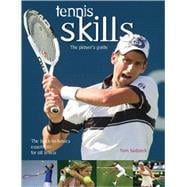
Note: Supplemental materials are not guaranteed with Rental or Used book purchases.
Purchase Benefits
What is included with this book?
Tom Sadzeck has been playing and coaching tennis for 25 years. He is now Director of Tennis and runs all junior programming for "Tennis in Marin," north of San Francisco. He has lectured as USTA coaching conferences and serves on the board of directors for the USTA Northern California Recreational Development Committee.
| Introduction | 7 | (1) | |||
|
8 | (2) | |||
|
10 | (2) | |||
|
12 | (2) | |||
|
14 | (4) | |||
|
18 | (38) | |||
|
56 | (16) | |||
|
72 | (18) | |||
|
90 | (16) | |||
|
106 | (10) | |||
|
116 | (12) | |||
| Index | 128 |
The New copy of this book will include any supplemental materials advertised. Please check the title of the book to determine if it should include any access cards, study guides, lab manuals, CDs, etc.
The Used, Rental and eBook copies of this book are not guaranteed to include any supplemental materials. Typically, only the book itself is included. This is true even if the title states it includes any access cards, study guides, lab manuals, CDs, etc.